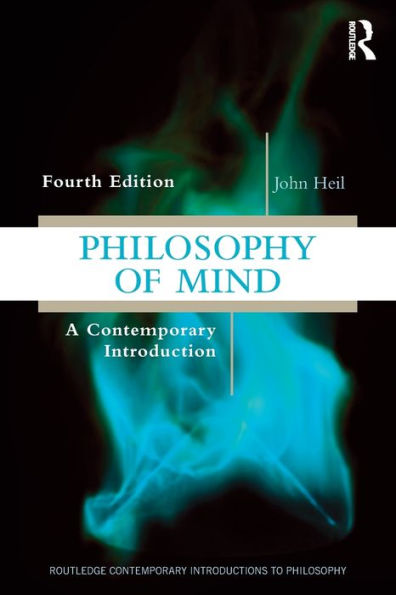Table of Contents
List of Figures xii
Preface to the Fourth Edition xiv
Preface to the Third Edition xvi
Preface to the Second Edition xviii
Preface to the First Edition xx
1 Introduction 1
1.1 Appearance and Reality 1
1.2 The Unavoidability of the Philosophy of Mind 3
1.3 Science and Metaphysics 4
1.4 Metaphysics and Cognitive Science 5
1.5 A Look Ahead 6 Suggested Reading 14
2 Cartesian Dualism 17
2.1 Science and Philosophy 17
2.2 Descartes's Dualism 18
2.3 Substances, Attributes, Modes 21
2.4 The Metaphysics of Cartesian Dualism 22
2.5 Mind-Body Interaction 24
2.6 A Causally Closed Universe 28
Suggested Reading 29
3 Descartes's Legacy 31
3.1 Dualism Without Interaction: Parallelism 31
3.2 Occasionalism 33
3.3 Causation and Occasionalism 34
3.4 Idealism 38
3.5 Mind and Meaning 39
3.6 Epiphenomenalism 42
3.7 Coda: Non-Cartesian Dualism 44
Suggested Reading 48
4 Mind and Behavior 50
4.1 Moving Away From Dualism 50
4.2 Historical and Philosophical Background 51
4.3 Other Minds 53
4.4 The Beetle in the Box 54
4.5 Philosophical Behaviorism 56
4.6 Dispositions 58
4.7 Behavioral Analysis 59
4.8 Sensation 61
4.9 The Legacy of Philosophical Behaviorism 62
4.10 Intrinsic Characteristics 63
4.11 'Experimental Methods and Conceptual Confusion' 64
4.12 Psychological Behaviorism 65
4.13 The Demise of Behaviorism 67
4.14 Behavior 67
Suggested Reading 69
5 The Identity Theory 71
5.1 From Correlation to Identification 71
5.2 Parsimony 72
5.3 Self-Conscious Thought 73
5.4 Locating Mental Qualities 74
5.5 Substances, Properties, States, and Events 75
5.6 Predicates and Properties 77
5.7 Strict Identity 78
5.8 Leibniz's Law 79
5.9 The $64 Question 80
5.10 The Phenomenological Fallacy 81
5.11 Epistemological Loose Ends 84
5.12 Taking Stock 85
Suggested Reading 87
6 Functionalism 88
6.1 The Rise of Functionalism 88
6.2 The Functionalist Picture 89
6.3 Abstraction as Partial Consideration 90
6.4 Minds as Programs 90
6.5 Functional Explanation 91
6.6 Functionalist Metaphysics 92
6.7 Functionalism and Materialism 94
6.8 Functional Properties 95
6.9 Mental Properties as Functional Properties 97
6.10 Functionalism and Behaviorism 98
6.11 Characterizing Functional States 100
6.12 Functional Systems Generally 103
6.13 Moving Beyond Analogy 104
Suggested Reading 104
7 The Representational Theory of Mind 106
7.1 Mental Representation 106
7.2 Semantic Engines 109
7.3 Minds as Semantic Engines 112
7.4 The Turing Test 113
7.5 The Chinese Room 115
7.6 From Syntax to Semantics 117
7.7 Thinking as Computing 118
7.8 Levels of Description 119
7.9 From Taxonomy to Ontology 121
7.10 Layers of Reality 124
Suggested Reading 125
8 Radical Interpretation 127
8.1 Minds as Constructs 127
8.2 The Propositional Attitudes 128
8.3 Semantic Opacity 129
8.4 Radical Interpretation: Background Issues 129
8.5 T-Theories 132
8.6 From T-Theories to I-Theories 134
8.7 Decision Theory 135
8.8 Sound and Fury Signifying Nothing? 136
8.9 Charity 137
8.10 Indeterminacy 138
8.11 The Omniscient Interpreter 139
8.12 Interpretation and Measurement 140
8.13 Structure and Content 142
8.14 Mental Causation and the Propositional Attitudes 144
8.15 An Apparent Regress 146
Suggested Reading 149
9 The Intentional Stance 151
9.1 From Davidson to Dennett 151
9.2 Taking a Stance 151
9.3 From Intentional Stance to Design Stance 154
9.4 From Design Stance to Physical Stance 155
9.5 The Emerging Picture 156
9.6 Thought and Language 157
9.7 Kinds of Mind 159
9.8 Consciousness 161
9.9 Searle's Objection 163
Suggested Reading 165
10 Eliminativism 166
10.1 From Instrumental ism to Eliminativism 166
10.2 Ontological Commitment 167
10.3 Theories and Theory Reduction 169
10.4 Stich's Argument 171
10.5 Prospects for Reduction or Elimination 174
10.6 Is Eliminativism Self-Refuting? 175
Suggested Reading 176
11 Non-Reductive Physicalism 178
11.1 From Substances to Properties 178
11.2 Substance Monism, Property Dualism 179
11.3 Mental Causation: Background Issues 181
11.4 Mental-Physical Supervenience 182
11.5 Causal Relevance 184
11.6 The Causal Relevance of Mental Properties 186
11.7 The Challenge of Causal Relevance 188
11.8 Jettisoning Higher-Level Properties 190
11.9 The Upshot 191
Suggested Reading 192
12 Consciousness 194
12.1 The Status of 'Raw Feels' 194
12.2 The Mystery of Consciousness 197
12.3 Qualities of Conscious Experiences 198
12.4 Zombies 200
12.5 Biting the Bullet 202
12.6 Contrary Mary 204
12.7 Representationalism 207
12.8 Consciousness as Higher-Order Representation 210
12.9 Explaining Consciousness 212
Suggested Reading 212
13 Emergence and Panpsychism 214
13.1 Emergence 214
13.2 'Downward Causation' 216
13.3 Panpsychism 220
13.4 Emergence or Panpsychism? 223
Suggested Reading 223
14 The Mind's Place in Nature 225
14.1 Applied Metaphysics 225
14.2 Multiple Readability and Levels of Reality 225
14.3 Zapping Zombies 226
14.4 Qualities of Conscious Experience 228
14.5 Imagery and Intentionality 230
14.6 Putting Imagery to Work 232
14.7 Twin-Earth 233
14.8 Intentionality Delivered 234
14.9 Functionalism Adieu 236
14.10 Dénouement 237
14.11 An Affectionate Farewell 240
Suggested Reading 240
References 243
Index 256






